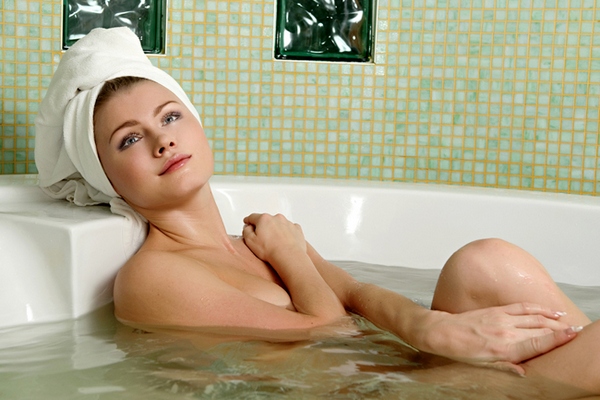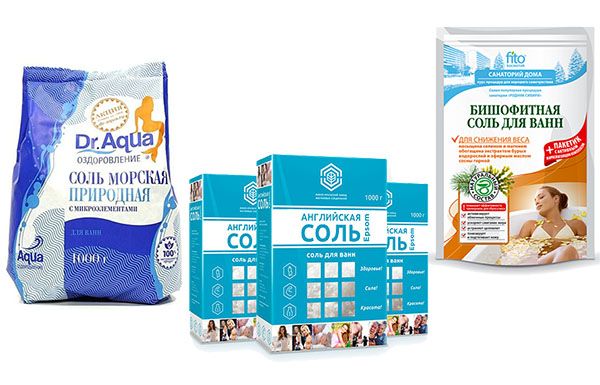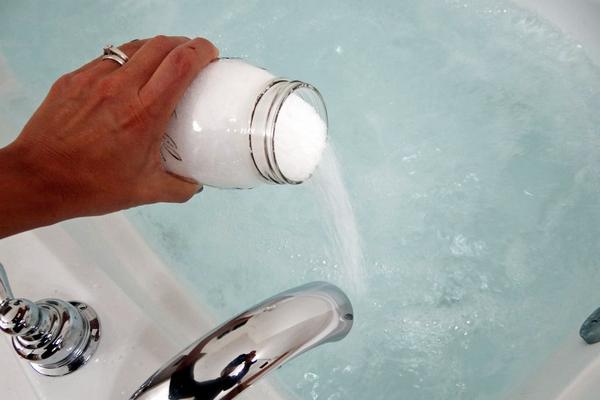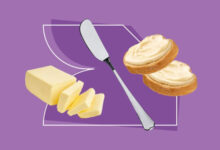- Nature and promises results
- Mechanism of action
- When you should not take baths
- Conclusions
Hot salt baths are one of the most popular among the many recipes for home spa treatments. In fact, this is both inexpensive and fast: from 0.5 to 1 kg of salt, 10-20 minutes of your time – and minus 0.5 kg of weight, and as nice bonuses – strong nails and hair, and enhanced metabolism. Is this actually the case? Let’s find out.
Nature and Promises

So, how to take baths with salt for weight loss:
- Take a shower, use a scrub.
- Take from 500 to 1000 g of salt, dissolve it in a filled bathtub. The amount of water should be such that when you immerse yourself in it, it does not cover your heart area. The water temperature should be 36-39 degrees. Stay in the bath for 10 to 20 minutes, depending on how you feel.
- Rub your body vigorously with a towel without rinsing, wrap yourself in a blanket or bedspread, and rest for at least half an hour.
- Do not eat 2 hours before the procedure and 2 hours after it. You can drink.
- The course of treatment is 10-15 procedures.
You can use either sea salt or rock salt. Most sources do not recommend using evaporated salt, which supposedly has a changed structure and lacks beneficial components. The recipe can vary. For example:
- Epsom salt baths: Mix 100 g of magnesium sulfate (Epsom salt itself) with regular or sea salt in a 1 to 5 ratio;
- Salt-soda baths: 500 g of salt + 250-500 g of baking soda (we wrote about the effectiveness of soda baths for weight loss earlier);
- Baths with essential oils: Add a few drops of essential oil to the salt before dissolving it in the bathroom. Grapefruit, orange or cedar oil will do.
What salt baths promise
Here are the results from a home bath for weight loss that are promised:
- Loss of 300-500 g of weight at a time;
- Strengthening of nails and hair;
- Removal of toxins and waste products;
- Removal of excess cholesterol;
- Normalization of hormonal balance due to “useful microelements” that supposedly “penetrate the body through the skin”;
- Elimination of stretch marks and cellulite.
It sounds good and promising. But what happens in reality?
Mechanism of Action

In order to understand the mechanism of action of salt baths for weight loss, we’ll have to take a quick excursion into chemistry.
Lyrical digression
If two solutions of different concentrations are separated by a semipermeable membrane – that is, one that allows only solvent molecules to pass through – the solvent will move towards the solution that has a higher concentration of the dissolved substance. This phenomenon is called “osmosis,” and the pressure created in this way is called osmotic.
It is osmotic pressure that creates the elasticity of the tissues of all living organisms, and that regulates the exchange of water between the cell and the extracellular space. The membrane of any cell is, in fact, a semipermeable membrane: water molecules penetrate it through ordinary diffusion, and all other substances only through special channels with the help of carrier proteins.
A solution whose osmotic pressure is equal to the osmotic pressure of human blood plasma is called isotonic. A solution with a higher osmolarity is called hypertonic, and a solution with a lower osmolarity is called hypotonic. All solutions for intravenous administration (droppers) are isotonic to avoid the death of blood cells due to dehydration or, conversely, excessive water intake.
Returning to baths for weight loss
Chemically, salt is sodium chloride. And the basis of the solution in the bath will be exactly that: sodium and chlorine ions, regardless of whether it’s a bath with table salt from the nearest grocery store or something more exotic. Yes, natural sea salt will also contain iodine (just like regular iodized salt), magnesium, potassium, bromine, and other impurities. Some of them – like those from the Dead Sea – will have more of them. Others – those obtained by evaporation – will contain a minimum of impurities.
After the recommended amount of salt is dissolved in a regular bathtub, half full or even one third (so that the water does not reach the heart area), a hypertonic solution is formed. It begins to draw intracellular fluid from the skin, carefully treated with a scrub (in order to clear the pores).
Such water loss is not dangerous in and of itself – if the human body were so easily prone to fatal dehydration, then humanity would have died out after the first sea bath. However, a sea salt bath – like any other – will do little good. At least much less than promised.
Will the swelling go away?
Yes, due to the removal of excess water, as well as sweat, because 38 degrees is already hotter than the body needs.
Will cellulite disappear?
Most likely: a scrub before taking salt baths, removal of stagnant fluid, active massage with a terry towel, etc. 10-15 times is an excellent course of anti-cellulite procedures.
Stretch marks?
It is unlikely that new stretch marks will become less visible, and old scars are essentially scars, and other methods are needed to get rid of them.
Do nails get stronger?
It is also possible; baths with a strong salt solution are a traditional remedy for brittle nails, but no one has collected any statistics on this. Hair – definitely not.
Will cholesterol be removed?
No, its molecule is too large to pass through the skin.
As for toxins and waste products, everyone talks about them, but no one can say specifically what these terms mean.
It is also impossible to talk about any penetration of beneficial microelements through the pores, since it is water that will move out of the body, not salts into the body.
When you should not take baths

Like any other physiotherapy procedure, salt baths for weight loss have their own contraindications:
- Wounds and abrasions on the skin;
- Chronic cardiovascular insufficiency;
- Dry, sensitive skin;
- Lactation – dehydration can reduce the amount of milk;
- Malignant neoplasms;
- High body temperature.
Salt baths should be used with great care during pregnancy: being in hot water can cause miscarriage. Being in water at a comfortable temperature during pregnancy is, in principle, not contraindicated.
The same applies to those suffering from hypertension or varicose veins: overheating is contraindicated for them, but water procedures are not prohibited in general. When rubbing the body after bathing, the area with varicose veins should be avoided.
Conclusions
So what’s the bottom line? Feeling good after a pleasant water procedure. Reduced swelling. Improved skin appearance. It is possible that appetite may decrease if the procedure is performed before bedtime (you cannot eat for two hours before taking a bath). A slight decrease in weight due to dehydration, which will disappear as soon as the water-salt metabolism returns to normal. That’s all the results.
As an adjunct – to relax and tighten the skin a little during weight loss – the baths can be used. But counting on anything more is pointless.
Read also: “Salt wraps for weight loss“.



